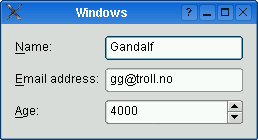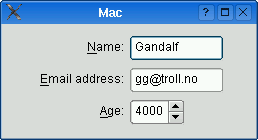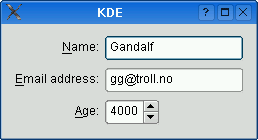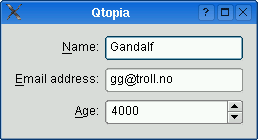The QFormLayout class manages forms of input widgets and their associated labels. 更多...
| 头: | #include <QFormLayout> |
| qmake: | QT += widgets |
| Since: | Qt 4.4 |
| 继承: | QLayout |
| class | TakeRowResult |
| enum | FieldGrowthPolicy { FieldsStayAtSizeHint, ExpandingFieldsGrow, AllNonFixedFieldsGrow } |
| enum | ItemRole { LabelRole, FieldRole, SpanningRole } |
| enum | RowWrapPolicy { DontWrapRows, WrapLongRows, WrapAllRows } |
|
|
| QFormLayout (QWidget * parent = Q_NULLPTR) | |
| ~QFormLayout () | |
| void | addRow (QWidget * label , QWidget * field ) |
| void | addRow (QWidget * label , QLayout * field ) |
| void | addRow (const QString & labelText , QWidget * field ) |
| void | addRow (const QString & labelText , QLayout * field ) |
| void | addRow (QWidget * widget ) |
| void | addRow (QLayout * layout ) |
| FieldGrowthPolicy | fieldGrowthPolicy () const |
| Qt::Alignment | formAlignment () const |
| void | getItemPosition (int index , int * rowPtr , ItemRole * rolePtr ) const |
| void | getLayoutPosition (QLayout * layout , int * rowPtr , ItemRole * rolePtr ) const |
| void | getWidgetPosition (QWidget * widget , int * rowPtr , ItemRole * rolePtr ) const |
| int | horizontalSpacing () const |
| void | insertRow (int row , QWidget * label , QWidget * field ) |
| void | insertRow (int row , QWidget * label , QLayout * field ) |
| void | insertRow (int row , const QString & labelText , QWidget * field ) |
| void | insertRow (int row , const QString & labelText , QLayout * field ) |
| void | insertRow (int row , QWidget * widget ) |
| void | insertRow (int row , QLayout * layout ) |
| QLayoutItem * | itemAt (int row , ItemRole role ) const |
| Qt::Alignment | labelAlignment () const |
| QWidget * | labelForField (QWidget * field ) const |
| QWidget * | labelForField (QLayout * field ) const |
| void | removeRow (int row ) |
| void | removeRow (QWidget * widget ) |
| void | removeRow (QLayout * layout ) |
| int | rowCount () const |
| RowWrapPolicy | rowWrapPolicy () const |
| void | setFieldGrowthPolicy (FieldGrowthPolicy policy ) |
| void | setFormAlignment (Qt::Alignment alignment ) |
| void | setHorizontalSpacing (int spacing ) |
| void | setItem (int row , ItemRole role , QLayoutItem * item ) |
| void | setLabelAlignment (Qt::Alignment alignment ) |
| void | setLayout (int row , ItemRole role , QLayout * layout ) |
| void | setRowWrapPolicy (RowWrapPolicy policy ) |
| void | setSpacing (int spacing ) |
| void | setVerticalSpacing (int spacing ) |
| void | setWidget (int row , ItemRole role , QWidget * widget ) |
| int | spacing () const |
| TakeRowResult | takeRow (int row ) |
| TakeRowResult | takeRow (QWidget * widget ) |
| TakeRowResult | takeRow (QLayout * layout ) |
| int | verticalSpacing () const |
| virtual void | addItem (QLayoutItem * item ) |
| virtual int | count () const |
| virtual Qt::Orientations | expandingDirections () const |
| virtual bool | hasHeightForWidth () const |
| virtual int | heightForWidth (int width ) const |
| virtual void | invalidate () |
| virtual QLayoutItem * | itemAt (int index ) const |
| virtual QSize | minimumSize () const |
| virtual void | setGeometry (const QRect & rect ) |
| virtual QSize | sizeHint () const |
| virtual QLayoutItem * | takeAt (int index ) |
The QFormLayout class manages forms of input widgets and their associated labels.
QFormLayout is a convenience layout class that lays out its children in a two-column form. The left column consists of labels and the right column consists of "field" widgets (line editors, spin boxes, etc.).
Traditionally, such two-column form layouts were achieved using QGridLayout . QFormLayout is a higher-level alternative that provides the following advantages:
例如, macOS Aqua and KDE guidelines specify that the labels should be right-aligned, whereas Windows and GNOME applications normally use left-alignment.
For devices with small displays, QFormLayout can be set to wrap long rows , or even to wrap all rows .
The addRow () 重载接受 QString 和 QWidget * creates a QLabel behind the scenes and automatically set up its buddy. We can then write code like this:
QFormLayout *formLayout = new QFormLayout; formLayout->addRow(tr("&Name:"), nameLineEdit); formLayout->addRow(tr("&Email:"), emailLineEdit); formLayout->addRow(tr("&Age:"), ageSpinBox); setLayout(formLayout);
Compare this with the following code, written using QGridLayout :
nameLabel = new QLabel(tr("&Name:")); nameLabel->setBuddy(nameLineEdit); emailLabel = new QLabel(tr("&Name:")); emailLabel->setBuddy(emailLineEdit); ageLabel = new QLabel(tr("&Name:")); ageLabel->setBuddy(ageSpinBox); QGridLayout *gridLayout = new QGridLayout; gridLayout->addWidget(nameLabel, 0, 0); gridLayout->addWidget(nameLineEdit, 0, 1); gridLayout->addWidget(emailLabel, 1, 0); gridLayout->addWidget(emailLineEdit, 1, 1); gridLayout->addWidget(ageLabel, 2, 0); gridLayout->addWidget(ageSpinBox, 2, 1); setLayout(gridLayout);
The table below shows the default appearance in different styles.
| QCommonStyle derived styles (except QPlastiqueStyle) | QMacStyle | QPlastiqueStyle | Qt Extended styles |
|---|---|---|---|

|

|

|

|
| Traditional style used for Windows, GNOME, and earlier versions of KDE. Labels are left aligned, and expanding fields grow to fill the available space. (This normally corresponds to what we would get using a two-column QGridLayout )。 | Style based on the macOS Aqua guidelines. Labels are right-aligned, the fields don't grow beyond their size hint, and the form is horizontally centered. | Recommended style for KDE applications . Similar to MacStyle, except that the form is left-aligned and all fields grow to fill the available space. | Default style for Qt Extended styles. Labels are right-aligned, expanding fields grow to fill the available space, and row wrapping is enabled for long lines. |
The form styles can be also be overridden individually by calling setLabelAlignment (), setFormAlignment (), setFieldGrowthPolicy (),和 setRowWrapPolicy (). For example, to simulate the form layout appearance of QMacStyle on all platforms, but with left-aligned labels, you could write:
formLayout->setRowWrapPolicy(QFormLayout::DontWrapRows); formLayout->setFieldGrowthPolicy(QFormLayout::FieldsStayAtSizeHint); formLayout->setFormAlignment(Qt::AlignHCenter | Qt::AlignTop); formLayout->setLabelAlignment(Qt::AlignLeft);
另请参阅 QGridLayout , QBoxLayout ,和 QStackedLayout .
This enum specifies the different policies that can be used to control the way in which the form's fields grow.
| 常量 | 值 | 描述 |
|---|---|---|
QFormLayout::FieldsStayAtSizeHint
|
0
|
The fields never grow beyond their effective size hint . This is the default for QMacStyle. |
QFormLayout::ExpandingFieldsGrow
|
1
|
Fields with an horizontal size policy of Expanding or MinimumExpanding will grow to fill the available space. The other fields will not grow beyond their effective size hint. This is the default policy for Plastique. |
QFormLayout::AllNonFixedFieldsGrow
|
2
|
All fields with a size policy that allows them to grow will grow to fill the available space. This is the default policy for most styles. |
另请参阅 fieldGrowthPolicy .
This enum specifies the types of widgets (or other layout items) that may appear in a row.
| 常量 | 值 | 描述 |
|---|---|---|
QFormLayout::LabelRole
|
0
|
A label widget. |
QFormLayout::FieldRole
|
1
|
A field widget. |
QFormLayout::SpanningRole
|
2
|
A widget that spans label and field columns. |
另请参阅 itemAt () 和 getItemPosition ().
This enum specifies the different policies that can be used to control the way in which the form's rows wrap.
| 常量 | 值 | 描述 |
|---|---|---|
QFormLayout::DontWrapRows
|
0
|
Fields are always laid out next to their label. This is the default policy for all styles except Qt Extended styles. |
QFormLayout::WrapLongRows
|
1
|
Labels are given enough horizontal space to fit the widest label, and the rest of the space is given to the fields. If the minimum size of a field pair is wider than the available space, the field is wrapped to the next line. This is the default policy for Qt Extended styles. |
QFormLayout::WrapAllRows
|
2
|
Fields are always laid out below their label. |
另请参阅 rowWrapPolicy .
This property holds the way in which the form's fields grow
The default value depends on the widget or application style. For QMacStyle, the default is FieldsStayAtSizeHint ; for QCommonStyle derived styles (like Plastique and Windows), the default is ExpandingFieldsGrow ; for Qt Extended styles, the default is AllNonFixedFieldsGrow .
If none of the fields can grow and the form is resized, extra space is distributed according to the current form alignment .
访问函数:
| FieldGrowthPolicy | fieldGrowthPolicy () const |
| void | setFieldGrowthPolicy (FieldGrowthPolicy policy ) |
另请参阅 formAlignment and rowWrapPolicy .
This property holds the alignment of the form layout's contents within the layout's geometry
The default value depends on the widget or application style. For QMacStyle, the default is Qt::AlignHCenter | Qt::AlignTop ; for the other styles, the default is Qt::AlignLeft | Qt::AlignTop .
访问函数:
| Qt::Alignment | formAlignment () const |
| void | setFormAlignment (Qt::Alignment alignment ) |
另请参阅 labelAlignment and rowWrapPolicy .
This property holds the spacing between widgets that are laid out side by side
By default, if no value is explicitly set, the layout's horizontal spacing is inherited from the parent layout, or from the style settings for the parent widget.
访问函数:
| int | horizontalSpacing () const |
| void | setHorizontalSpacing (int spacing ) |
另请参阅 verticalSpacing , QStyle::pixelMetric (),和 PM_LayoutHorizontalSpacing .
This property holds the horizontal alignment of the labels
The default value depends on the widget or application style. For QCommonStyle derived styles, except for QPlastiqueStyle, the default is Qt::AlignLeft ; for the other styles, the default is Qt::AlignRight .
访问函数:
| Qt::Alignment | labelAlignment () const |
| void | setLabelAlignment (Qt::Alignment alignment ) |
另请参阅 formAlignment .
This property holds the way in which the form's rows wrap
The default value depends on the widget or application style. For Qt Extended styles, the default is WrapLongRows ; for the other styles, the default is DontWrapRows .
If you want to display each label above its associated field (instead of next to it), set this property to WrapAllRows .
访问函数:
| RowWrapPolicy | rowWrapPolicy () const |
| void | setRowWrapPolicy (RowWrapPolicy policy ) |
另请参阅 fieldGrowthPolicy .
This property holds the spacing between widgets that are laid out vertically
By default, if no value is explicitly set, the layout's vertical spacing is inherited from the parent layout, or from the style settings for the parent widget.
访问函数:
| int | verticalSpacing () const |
| void | setVerticalSpacing (int spacing ) |
另请参阅 horizontalSpacing , QStyle::pixelMetric (),和 PM_LayoutHorizontalSpacing .
Constructs a new form layout with the given parent 小部件。
另请参阅 QWidget::setLayout ().
Destroys the form layout.
[虚拟]
void
QFormLayout::
addItem
(
QLayoutItem
*
item
)
重实现自 QLayout::addItem ().
Adds a new row to the bottom of this form layout, with the given label and field .
另请参阅 insertRow ().
这是重载函数。
这是重载函数。
This overload automatically creates a QLabel behind the scenes with labelText as its text. The field is set as the new QLabel 's buddy .
这是重载函数。
This overload automatically creates a QLabel behind the scenes with labelText as its text.
这是重载函数。
Adds the specified widget at the end of this form layout. The widget spans both columns.
这是重载函数。
Adds the specified layout at the end of this form layout. The layout spans both columns.
[虚拟]
int
QFormLayout::
count
() const
重实现自 QLayout::count ().
[虚拟]
Qt::Orientations
QFormLayout::
expandingDirections
() const
重实现自 QLayoutItem::expandingDirections ().
Retrieves the row and role (column) of the item at the specified index 。若 index is out of bounds, * rowPtr is set to -1; otherwise the row is stored in * rowPtr and the role is stored in * rolePtr .
另请参阅 itemAt (), count (), getLayoutPosition (),和 getWidgetPosition ().
Retrieves the row and role (column) of the specified child layout 。若 layout is not in the form layout, * rowPtr is set to -1; otherwise the row is stored in * rowPtr and the role is stored in * rolePtr .
Retrieves the row and role (column) of the specified widget in the layout. If widget is not in the layout, * rowPtr is set to -1; otherwise the row is stored in * rowPtr and the role is stored in * rolePtr .
另请参阅 getItemPosition () 和 itemAt ().
[虚拟]
bool
QFormLayout::
hasHeightForWidth
() const
重实现自 QLayoutItem::hasHeightForWidth ().
[虚拟]
int
QFormLayout::
heightForWidth
(
int
width
) const
重实现自 QLayoutItem::heightForWidth ().
Inserts a new row at position row in this form layout, with the given label and field 。若 row is out of bounds, the new row is added at the end.
另请参阅 addRow ().
这是重载函数。
这是重载函数。
This overload automatically creates a QLabel behind the scenes with labelText as its text. The field is set as the new QLabel 's buddy .
这是重载函数。
This overload automatically creates a QLabel behind the scenes with labelText as its text.
这是重载函数。
Inserts the specified widget 在位置 row in this form layout. The widget spans both columns. If row is out of bounds, the widget is added at the end.
这是重载函数。
Inserts the specified layout 在位置 row in this form layout. The layout spans both columns. If row is out of bounds, the widget is added at the end.
[虚拟]
void
QFormLayout::
invalidate
()
重实现自 QLayoutItem::invalidate ().
Returns the layout item in the given row 采用指定 role (column). Returns 0 if there is no such item.
另请参阅 QLayout::itemAt () 和 setItem ().
[虚拟]
QLayoutItem
*QFormLayout::
itemAt
(
int
index
) const
重实现自 QLayout::itemAt ().
Returns the label associated with the given field .
另请参阅 itemAt ().
这是重载函数。
[虚拟]
QSize
QFormLayout::
minimumSize
() const
重实现自 QLayoutItem::minimumSize ().
Deletes row row from this form layout.
row must be non-negative and less than rowCount ().
After this call, rowCount () is decremented by one. All widgets and nested layouts that occupied this row are deleted. That includes both the field widget(s) and the label, if any. All following rows are shifted up one row and the freed vertical space is redistributed amongst the remaining rows.
You can use this function to undo a previous addRow () 或 insertRow ():
QFormLayout *flay = ...; QPointer<QLineEdit> le = new QLineEdit; flay->insertRow(2, "User:", le); // later: flay->removeRow(2); // le == nullptr at this point
If you want to remove the row from the layout without deleting the widgets, use takeRow () 代替。
该函数在 Qt 5.8 引入。
另请参阅 takeRow ().
这是重载函数。
Deletes the row corresponding to widget from this form layout.
After this call, rowCount () is decremented by one. All widgets and nested layouts that occupied this row are deleted. That includes both the field widget(s) and the label, if any. All following rows are shifted up one row and the freed vertical space is redistributed amongst the remaining rows.
You can use this function to undo a previous addRow () 或 insertRow ():
QFormLayout *flay = ...; QPointer<QLineEdit> le = new QLineEdit; flay->insertRow(2, "User:", le); // later: flay->removeRow(le); // le == nullptr at this point
If you want to remove the row from the layout without deleting the widgets, use takeRow () 代替。
该函数在 Qt 5.8 引入。
另请参阅 takeRow ().
这是重载函数。
Deletes the row corresponding to layout from this form layout.
After this call, rowCount () is decremented by one. All widgets and nested layouts that occupied this row are deleted. That includes both the field widget(s) and the label, if any. All following rows are shifted up one row and the freed vertical space is redistributed amongst the remaining rows.
You can use this function to undo a previous addRow () 或 insertRow ():
QFormLayout *flay = ...; QPointer<QVBoxLayout> vbl = new QVBoxLayout; flay->insertRow(2, "User:", vbl); // later: flay->removeRow(layout); // vbl == nullptr at this point
If you want to remove the row from the form layout without deleting the inserted layout, use takeRow () 代替。
该函数在 Qt 5.8 引入。
另请参阅 takeRow ().
Returns the number of rows in the form.
另请参阅 QLayout::count ().
[虚拟]
void
QFormLayout::
setGeometry
(const
QRect
&
rect
)
重实现自 QLayoutItem::setGeometry ().
设置项在给定 row 为给定 role to item , extending the layout with empty rows if necessary.
If the cell is already occupied, the item is not inserted and an error message is sent to the console. The item spans both columns.
警告: 不要使用此函数添加子级布局 (或子级 Widget 项)。使用 setLayout () 或 setWidget () 代替。
另请参阅 setLayout ().
Sets the sub-layout in the given row 为给定 role to layout , extending the form layout with empty rows if necessary.
If the cell is already occupied, the layout is not inserted and an error message is sent to the console.
注意: For most applications, addRow () 或 insertRow () should be used instead of setLayout().
另请参阅 setWidget ().
This function sets both the vertical and horizontal spacing to spacing .
另请参阅 spacing (), setVerticalSpacing (),和 setHorizontalSpacing ().
Sets the widget in the given row 为给定 role to widget , extending the layout with empty rows if necessary.
If the cell is already occupied, the widget is not inserted and an error message is sent to the console.
注意: For most applications, addRow () 或 insertRow () should be used instead of setWidget().
另请参阅 setLayout ().
[虚拟]
QSize
QFormLayout::
sizeHint
() const
重实现自 QLayoutItem::sizeHint ().
If the vertical spacing is equal to the horizontal spacing, this function returns that value; otherwise it returns -1.
另请参阅 setSpacing (), verticalSpacing (),和 horizontalSpacing ().
[虚拟]
QLayoutItem
*QFormLayout::
takeAt
(
int
index
)
重实现自 QLayout::takeAt ().
移除指定 row from this form layout.
row must be non-negative and less than rowCount ().
注意: This function doesn't delete anything.
After this call, rowCount () is decremented by one. All following rows are shifted up one row and the freed vertical space is redistributed amongst the remaining rows.
You can use this function to undo a previous addRow () 或 insertRow ():
QFormLayout *flay = ...; QPointer<QLineEdit> le = new QLineEdit; flay->insertRow(2, "User:", le); // later: QFormLayout::TakeRowResult result = flay->takeRow(2);
If you want to remove the row from the layout and delete the widgets, use removeRow () 代替。
Returns A structure containing both the widget and corresponding label layout items
该函数在 Qt 5.8 引入。
另请参阅 removeRow ().
这是重载函数。
移除指定 widget from this form layout.
注意: This function doesn't delete anything.
After this call, rowCount () is decremented by one. All following rows are shifted up one row and the freed vertical space is redistributed amongst the remaining rows.
QFormLayout *flay = ...; QPointer<QLineEdit> le = new QLineEdit; flay->insertRow(2, "User:", le); // later: QFormLayout::TakeRowResult result = flay->takeRow(widget);
If you want to remove the row from the layout and delete the widgets, use removeRow () 代替。
Returns A structure containing both the widget and corresponding label layout items
该函数在 Qt 5.8 引入。
另请参阅 removeRow ().
这是重载函数。
移除指定 layout from this form layout.
注意: This function doesn't delete anything.
After this call, rowCount () is decremented by one. All following rows are shifted up one row and the freed vertical space is redistributed amongst the remaining rows.
QFormLayout *flay = ...; QPointer<QVBoxLayout> vbl = new QVBoxLayout; flay->insertRow(2, "User:", vbl); // later: QFormLayout::TakeRowResult result = flay->takeRow(widget);
If you want to remove the row from the form layout and delete the inserted layout, use removeRow () 代替。
Returns A structure containing both the widget and corresponding label layout items
该函数在 Qt 5.8 引入。
另请参阅 removeRow ().